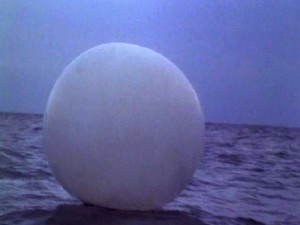Be Seeing You
Ami Clarke
23 January – 9 April 2012
+
UN-PUBLISH (publication)
Ami Clarke
.
Tokyo Art Beat | Glass | Metropolis
 情報で溢れかえる今日の社会において、私たちは日々、自分が受信する情報の選別は勿論、自分の発信する情報もコントロールしています。何をどこまで公にするかという問題は、一個人の杞憂でありつつ政府も頭を悩ます問題です。
情報で溢れかえる今日の社会において、私たちは日々、自分が受信する情報の選別は勿論、自分の発信する情報もコントロールしています。何をどこまで公にするかという問題は、一個人の杞憂でありつつ政府も頭を悩ます問題です。
今回のインスタレーションBe Seeing Youは、二つのビデオ作品を通して、資本主義社会における個人情報の要求、また強制的搾取について言及します。
二つのビデオのうち一つは、1960年代にイギリスで放送され、今もなおカルト的人気を誇るSFテレビドラマ『ザ・プリズナー』を引用し、ドラマ内に登場するローバーと呼ばれる白い円形の物体を、恐怖と抑圧の象徴としてピックアップします。
繋ぎ合わされた映像の断片、反復するイメージ、光の明滅。映像を見るうちに、観客は、否応無しに作品の織りなす世界へ取り込まれてしまいます。マクルーハンの「聴覚は単一の視点を持たない…私たちは音に内包されている」という言葉を用いるなら、クラークのビデオ作品は視点をもたないことにより、聴覚的な視覚体験を可能にしていると言えるでしょう。
このような特殊な視覚体験に加え、作品の持つユーモアの要素も、様々な解釈の可能性を秘めています。
「コミュニケーション・システムとしてのユーモア、また、社会問題として表れるユーモアは…論説としてではなく、実体験で感じられる人々の感性の変化を表す指標として意味がある…今日のユーモアには筋書きがなく、ほとんどの場合が、圧縮され積み重ねられた物語だ。」(1964)
もう一つのビデオ作品”Eye Technics” 2012 (ビデオ、0.53分)は、目の構造を意識し、潜望鏡の中を覗き込む形で設置されます。
また今回の展示では、クラークのアートブック”UN-PUBLISH”の出版記念もかね、来場者に彼女の本を無料で配布いたします(Banner Repeater, London提供)
“UNPUBLISH”では、ブラッドリー・マニング、ザク・アントルペ、エイドリアン・ラモの間の架空のオンライン・チャット記録、そして、ハンス・ウルリッヒ=オブリヒトによるジュリアン・アサンジュへのインタビューなど、権力者側による情報操作が”un-publish”(非公開)として公開されています。
「歴史の書き換え操作」とも言える情報の抹殺は、今に始まったことではありません。20世紀初頭には、旧ソビエト連合が政府の不都合になる写真を数千枚消去していますし、近年では、中国や北朝鮮、アラブの春の真っただ中にある中東諸国、また皮肉にも言論の自由を掲げるアメリカ合衆国までもが、人々の言説をコントロールし、情報の書き換えや消去を行っています。
また、会期中にエイミー・クラークによるアーティスト・トークも予定しております。(トークについての詳細は近日発表する予定です)
皆さま、ぜひ、エイミー・クラークの日本での初個展をご高覧下さい。
.
Controlling the flow of information has become a significant feature of our current lives. Ranging from the personal decision one makes about what information to post online to the on-going efforts of governments and agencies to manage and restrict the release or accessibility of certain information to the public.
Be Seeing You is an installation consisting of two videos, one a small excerpt from the other, which explore notions of both the coercion to offer personal information and late capitalisms embrace of the technology that allows the mining of such details to facilitate every waking moment as a financially contracted transaction.
The installed works take inspiration from the 60’s cult science-fiction British television programme “The Prisoner,” and focuses on “Rover” – an animated object, typical of early lo-fi science fiction, used by the authorities to intimidate residents of “the village”.
Treating the collection of appropriated footage in a way more akin to a research project, the film: “Be Seeing You” explores the multiple perspectives afforded by film technology, and touches on relations between the audience and projected image.
The immersive environment creates a visual equivalent of certain kinds of auditory stimulation, an aural world, as M. McLuhan noted “the ear favours no particular “point of view”… “we are all enveloped by sound”.
The emphasis on an experiential encounter with video that speaks perhaps of an authentic physiological experience, is complicated by the slippage that occurs between audio and visual affects, and the relentlessly hypnotic affect of the pulsing light.
The humour in the repeated sections of footage, suggests a multitude of possibilities.
“Humour as a system of communications and as a problem of our environment – of what’s really going on … does not deal in theory, but in immediate experience, and is often the best guide to changing perceptions……..today’s humour, on the contrary, has no story line – no sequence. It is usually a compressed overlay of stories.” (1964)
The accompanying video, “Eye-Technics”, 2012 (mini single screen digital video work with sound, duration: 0.53 min, looped), presented in a periscope plinth, is a parodic take on the mechanism of the eye itself.
The exhibition at The Container is also launching Clarke’s new publication, “UN-PUBLISH” (2012) which will be available to visitors free-of-charge (distributed by Banner Repeater, London).
The publication, outlining online and SMS conversations between Bradley Manning and Zak Antaloupe, Adrian Lamo, and an imagined communique with Julian Assange, refers to an interview by Hans Ulrich Obrist and Assange where the authorities re-management of information is addressed as “un-publishing”.
This process of deleting information in an effort to “rewrite” history is of course not a new notion and recalls of the early 20th century “purges” of the Soviet Union where thousands of photographs were re-appropriated; or more recently the efforts of China, North Korea or Arab Spring countries to control what people see or post. It is ironic that the American government, who so adamantly condemned this activity of the Soviet Union during the cold war, is entangled in the most publicized effort in history to rewrite the news.
Kindly supported by A.R.T. (Tokyo) and Banner Repeater (London)
.
.